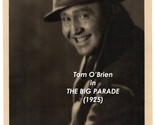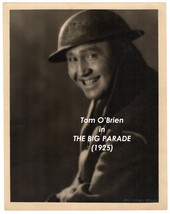Rendered at 22:12:25 05/30/25
King Vidor's THE BIG PARADE (1925) Tom O'Brien Double-Wt BY RUTH HARRIET LOUISE
$250.00
Shipping options
Offer policy
OBO - Seller accepts offers on this item.
Details
Return policy
Refunds available: See booth/item description for details
Details
Purchase protection
Payment options
PayPal accepted
PayPal Credit accepted
Venmo accepted
PayPal, MasterCard, Visa, Discover, and American Express accepted
Maestro accepted
Amazon Pay accepted
Nuvei accepted
Shipping options
Offer policy
OBO - Seller accepts offers on this item.
Details
Return policy
Refunds available: See booth/item description for details
Details
Purchase protection
Payment options
PayPal accepted
PayPal Credit accepted
Venmo accepted
PayPal, MasterCard, Visa, Discover, and American Express accepted
Maestro accepted
Amazon Pay accepted
Nuvei accepted
Item traits
| Category: | |
|---|---|
| Quantity Available: |
Only one in stock, order soon |
| Condition: |
Unspecified by seller, may be new. |
| Country/Region of Manufacture: |
United States |
| Size: |
11x14 inches |
| Style: |
Black & White |
| Industry: |
Movies |
| Year: |
Pre-1940 |
| Object Type: |
Photograph |
| Original/Reproduction: |
Original |
| Photographer: |
Ruth Harriet Louise |
| Actors: |
Tom O'Brien (as "Bull") |
| Item Number: |
S-PARADE-04 |
| LOC: |
SCI-B2 |
| Modified Item: |
No |
| Film Title: |
The Big Parade |
| Studio: |
Metro-Goldwyn-Mayer (MGM) |
| Year of Release: |
1925 |
| Director: |
King Vidor |
| Item: |
Vintage original double-weight matte photograph |
Listing details
| Seller policies: | |
|---|---|
| Shipping discount: |
No combined shipping offered |
| Posted for sale: |
More than a week ago |
| Item number: |
1193648809 |
Item description
Vintage original 11x14 in. US double-weight textured matte-finish photograph from the classic 1920's WWI-themed silent film drama/romance, THE BIG PARADE, released in 1925 by Metro-Goldwyn-Mayer (MGM) and directed by King Vidor. Based upon a story by World War I veteran, Laurence Stallings, the film is about an idle rich boy (John Gilbert) who joins the US Army's Rainbow Division and is sent to France to fight in World War I, becomes a friend of two working class men (Tom O'Brien, Karl Dane), experiences the horrors of trench warfare, and finds love with a French girl (Renée Adorée). The cast includes Hobart Bosworth, Claire McDowell, Claire Adams, Robert Ober, George Beranger, Julanne Johnston, and Kathleen Key.
This oversized photograph depicts an interior studio shot of cast member Tom O'Brien in costume as WWI doughboy "Bull." This photograph was taken by Ruth Harriet Louise and features her blindstamp credit in the lower right corner. There is also a rubber stamp credit to Miss Louise on the top of the verso along with an unrelated rubber stamp credit. Printed on double-weight stock with a beautiful textured matte finish, this photograph is in very fine condition without any pinholes, creases, tears, stains, writing, or other flaws. Vintage original photographs by Ruth Harriet Louise are very sought-after by collectors and continue to increase in value.
Ruth Harriet Louise (born Ruth Goldstein, January 13, 1903 – October 12, 1940) was an American photographer. She was the first woman photographer active in Hollywood and she ran Metro-Goldwyn-Mayer's portrait studio from 1925 to 1930. Louise began working as a portrait photographer in 1922, working out of a music store down the block from the New Brunswick temple at which her father was a rabbi. Most of her photographs from this period are of family members and members of her father's temple congregation.
In 1925, she moved to Los Angeles and established a small photo studio on Hollywood and Vine. Louise's first published Hollywood photo was of Vilma Banky in costume for The Dark Angel (1925), which appeared in Photoplay magazine in September 1925. When Louise was hired by MGM as chief portrait photographer, she was twenty-two years old and the only woman working as a portrait photographer for the Hollywood studios. In a career that lasted only five years, Louise photographed all the stars, contract players, and many of the hopefuls who passed through the studio's front gates, including Greta Garbo (Louise was one of only seven photographers permitted to make portraits of her), Lon Chaney, John Gilbert, Joan Crawford, Marion Davies, Anna May Wong, Nina Mae McKinney, and Norma Shearer. It is estimated that she took more than 100,000 photos during her tenure at MGM. Today she is considered an equal with George Hurrell Sr. and other renowned glamour photographers of the era. In addition to paying close attention to costume and setting for studio photographs, Louise also incorporated aspects of modernist movements such as Cubism, futurism, and German expressionism into her studio portraits.
The Big Parade has been praised for its realistic depiction of warfare, and it heavily influenced a great many subsequent war films, especially All Quiet on the Western Front (1930). The Big Parade is regarded as one of the greatest films made about World War I and, in 1992, it was selected for preservation in the United States National Film Registry by the Library of Congress. The Big Parade was one of the great hits of the 1920's, earning gross rentals of $4,990,000 in the United States and $1,141,000 overseas on a budget of $382,000 during its initial release, with MGM recording a profit of $3.4 million, its biggest of the silent era. The domestic earnings were MGM's biggest until the release of Gone with the Wind (1939). It played in some larger cities continually for a year or more, boosting Gilbert's career and made Renée Adorée a major star, although Adorée would soon be diagnosed with tuberculosis and die only a few years later. The film ultimately grossed $18–$22 million in worldwide rentals and is sometimes proclaimed as the most successful film of the silent era, although it is most likely this record falls to D.W. Griffith’s The Birth of a Nation (1915). The film won the Photoplay Magazine Medal for best film of the year in 1925. The medal is considered the first significant annual movie award, prior to the establishment of the Oscars.
After the film's producers found a clause in Vidor's contract that entitled the director to 20% of the net profits, studio lawyers called for a meeting with him. At the meeting, accountants upgraded the costs of the picture and downgraded their forecast of its potential success. Vidor was thus persuaded to sell his stake in the film before he could receive his percentage. However, the film's tremendous success established Vidor as one of MGM's top directors.
Added to your wish list!

- King Vidor's THE BIG PARADE (1925) Tom O'Brien Double-Wt BY RUTH HARRIET LOUISE
- 1 in stock
- Price negotiable
- Handling time 2 days. Estimated delivery: Fri, Jun 6th
- Returns/refunds accepted
Get an item reminder
We'll email you a link to your item now and follow up with a single reminder (if you'd like one). That's it! No spam, no hassle.
Already have an account?
Log in and add this item to your wish list.








